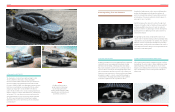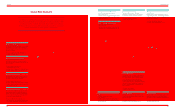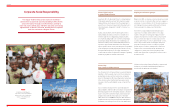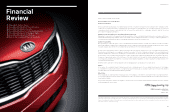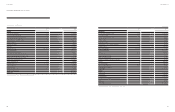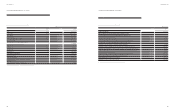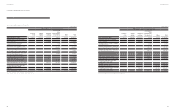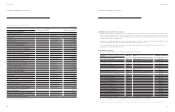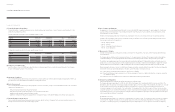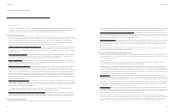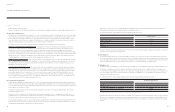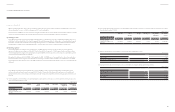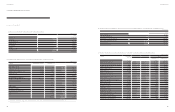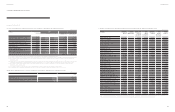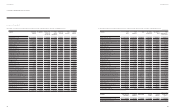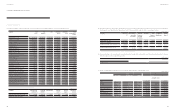Kia 2014 Annual Report Download - page 37
Download and view the complete annual report
Please find page 37 of the 2014 Kia annual report below. You can navigate through the pages in the report by either clicking on the pages listed below, or by using the keyword search tool below to find specific information within the annual report.
December 31, 2014 and 2013
Notes to the Consolidated
Financial Statements
KIA MOTORS CORPORATION AND SUBSIDIARIES
(c) Financial information of subsidiaries
Financial information of signicant subsidiaries (before eliminating intra-group transaction) as of and for the years ended December 31, 2014
and 2013 are summarized as follows:
(i) Financial information as of and for the year ended December 31, 2014
Company Total assets Total liabilities Sales Net income (Loss)
KMA ₩ 4,528,878 3,452,198 12,846,503 423,987
KMMG 2,206,318 1,399,460 7,685,561 151,836
KMS 2,516,976 1,428,020 6,415,996 395,051
KMR 889,520 834,289 3,517,360 (231,882)
(ii) Financial information as of and for the year ended December 31, 2013
Company Total assets Total liabilities Sales Net income
KMA ₩ 3,275,282 2,474,823 12,869,946 532,610
KMMG 1,984,718 1,256,690 8,073,095 207,923
KMS 2,767,738 1,572,813 6,464,346 335,564
KMR 772,588 414,746 4,187,462 170,430
(d) Changes in consolidation scope
Kia Motors Mexico S.A de C.V. (KMM) was newly established in 2014 and included in the consolidated nancial statements of the Company,
because the Company has 100% of the ownership.
2. Basis of Accounting
(a) Statement of compliance
The consolidated nancial statements have been prepared in accordance with Korean International Financial Reporting Standards (“K-IFRS”), as
prescribed in the Act on External Audit of Corporations in the Republic of Korea.
(b) Basis of measurement
The consolidated nancial statements have been prepared on the historical cost basis, except for the following material items in the consolidated
statements of nancial position:
ㆍ
Derivative nancial instruments are measured at fair value
ㆍ Financial instruments at fair value through prot or loss are measured at fair value
ㆍ Available-for-sale nancial assets are measured at fair value
ㆍ Liabilities for dened benet plans are recognized at the net of total present value of dened benet obligations less the fair value of plan assets
(c) Functional and presentation currency
The consolidated nancial statements are presented in Korean won, which is the Parent Company’s functional currency and the currency of the
primary economic environment in which the Company operates.
(KRW in millions)
(KRW in millions)
(d) Use of estimates and judgments
The preparation of the consolidated nancial statements in conformity with K-IFRS requires management to make judgments, estimates and
assumptions that affect the application of accounting policies and the reported amounts of assets, liabilities, income and expenses. Actual
results may differ from these estimates.
Estimates and underlying assumptions are reviewed on an ongoing basis. Revisions to accounting estimates are recognized prospectively.
Information about assumptions and estimation uncertainties that have a signicant risk of resulting in a material adjustment within the next
scal year are included in the following notes:
ㆍ
Note 16 : Employee Benets
ㆍ
Note 17 : Provisions
ㆍ
Note 18 : Commitments and Contingencies
ㆍ
Note 27 : Income Tax Expense
(e) Measurement of fair value
A number of the Company’s accounting policies and disclosures require the measurement of fair values, for both nancial and non-nancial
assets and liabilities.
The Company has an established control framework with respect to the measurement of fair values. This includes a valuation team that has
overall responsibility for overseeing all signicant fair value measurements, including Level 3 fair values, and reports directly to the CFO.
The valuation team regularly reviews signicant unobservable inputs and valuation adjustments. If third party information, such as broker quotes or
pricing services, is used to measure fair values, then the valuation team assesses the evidence obtained from the third parties to support the conclusion
that such valuations meet the requirements of K-IFRS, including the level in the fair value hierarchy in which such valuations should be classied.
When measuring the fair value of an asset or a liability, the Company uses market observable data as far as possible. Fair values are categorized
into different levels in a fair value hierarchy based on the inputs used in the valuation techniques as follows.
Level 1: quoted prices (unadjusted) in active markets for identical assets or liabilities.
Level 2: inputs other than quoted prices included in Level 1 that are observable for the asset or liability, either directly (i.e. as prices) or indirectly
(i.e. derived from prices).
Level 3: inputs for the asset or liability that are not based on observable market data (unobservable inputs).
(f) Changes in accounting policies
(i) Offsetting Financial Assets and Financial Liabilities (Amendments to K-IFRS No. 1032)
The Company has adopted amendments to K-IFRS No. 1032, ’Offsetting Financial Assets and Financial Liabilities’ since January 1, 2014. The
amendments clarify the meaning of ’currently has a legally enforceable right of set-off’. According to the amendments, the right to set off should
not be contingent on a future event, and legally enforceable in the normal course of business, in the event of default, and in the event of
insolvency or bankruptcy of the entity and all of the counterparties. The amendments also state that some gross settlement systems would be
considered equivalent to net settlement if they eliminate or result in insignicant credit and liquidity risk and process receivables and payables in a
single settlement process or cycle. The amendments to K-IFRS No. 1032 are not applied retrospectively, as the Company believes that the impact
on prior period nancial statements is immaterial.
(ii) K-IFRS No. 2121 ’Levies’
The Company adopted K-IFRS No. 2121 with a date of initial application of January 1, 2014. The interpretation, which is retrospectively applied,
conrms that the obligating event that gives rise to a liability to pay a levy is the activity that triggers the payment of the levy, as identied by
the legislation. The liability to pay a levy is recognized progressively if the obligating event occurs over a period of time and if the obligating
70 71
Annual Report 2014Financial Review



